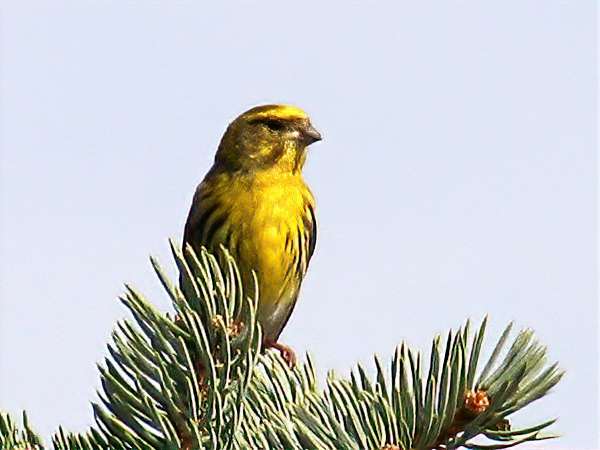 The Wild or “Typical” Canary (Serinus canaria) is the world’s most commonly-kept finch. However, several of its relatives are also well-established in captivity, and some have been hybridized with the Wild Canary in order to improve its color and singing abilities. One of these, the Green Singing Finch (S. mozambicus), is a common pet; please see the article below for more information. Today I’ll introduce the Gray Singing Finch, European Serin, Black-Throated and Black-Headed Canaries.
The Wild or “Typical” Canary (Serinus canaria) is the world’s most commonly-kept finch. However, several of its relatives are also well-established in captivity, and some have been hybridized with the Wild Canary in order to improve its color and singing abilities. One of these, the Green Singing Finch (S. mozambicus), is a common pet; please see the article below for more information. Today I’ll introduce the Gray Singing Finch, European Serin, Black-Throated and Black-Headed Canaries.
Note: “Wild Canary” as used here refers to the common pet trade Canary.
Gray Singing Finch (Serinus leucopygius)
Also known as the White-Rumped Serin or Layard’s Seedeater, the singing abilities of this bird are considered to be superior to those of the Wild Canary (please see video below). Aviculturists in search of talented songsters sometimes cross Gray Singing Finches with Wild Canaries.
This bird’s plumage is a non-descript gray in color, but few who have heard the male’s song take exception to this! Its range extends across North-Central Africa from Senegal to the Sudan, where it occupies overgrown scrub, parks and gardens.
Black-Throated Canary (Serinus atrogularis)
Also called the Yellow-Rumped Serin, this gray and yellow canary is a fine songster, although not quite on par with the Gray Singing Finch. Like many canary relatives, females construct intricately woven nests…I was presented with one that was so tightly knit that it seemed to have been spun by machine.
The Black-Throated Canary occupies a huge range; the 7 or so subspecies may be found from southern Saudi Arabia and Yemen through much of Africa south of the Sahara. Most populations favor open woodlands near water.
European Serin (Serinus serinus)
This popularly-kept canary (please see photo) sometimes occurs as far north as Great Britain, where it is strictly protected. It is also found in southern Europe, western Asia and northwestern Africa.
European Serins are attractively clad in bright to greenish-yellow and brown, and have been crossed with Wild Canaries by breeders seeking uniquely-colored birds. They are known for their fluttering, “butterfly-like” mating displays, and are often kept in outdoor aviaries so that this behavior can be shown to its best advantage.
Black-Headed Canary (Serinus alario)
Also sold under the name “Alario Finch”, this strikingly-marked canary is, at 5.5 inches in length, the largest member of the group. The black head, nape and throat contrast sharply with the cinnamon-red back and wings, as does the black stripe that marks the white breast.
Black-Headed Canaries are a bit more aggressive than related birds, and do best in thickly-planted outdoor aviaries. Mated pairs are not very tolerant of company, especially during the breeding season. Cross breeding this species with Wild Canaries was common in the past.
In the wild, Black-Headed Canaries occupy open woodlands and brushy fields in southern Africa.

Red-Hooded Siskin (Carduelis cucullata)
This gorgeous Venezuelan native (please see photo) is of a different genus than the canaries, but can mate with Wild Canaries and produce young, at least some of which will be fertile. Highly endangered in the wild, it is well-established in captivity and is the original source of the red coloring in “Red Factor” Wild Canaries. Please see the article below for details.
Further Reading
European Society of Serinus Breeders – info on breeding and conserving many canary relatives; great photos.
Video illustrating the wonderful abilities of the Gray Singing Finch.
European Serin image referenced from wikipedia and originally posted by Armin Marz
 That Bird Blog – Bird Care and History for Pet Birds
That Bird Blog – Bird Care and History for Pet Birds



